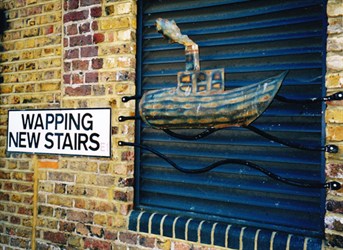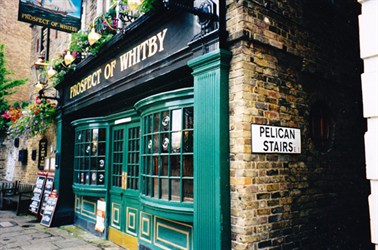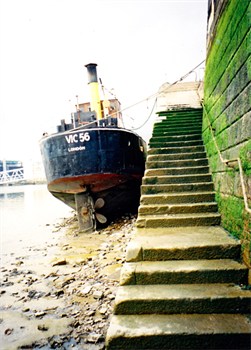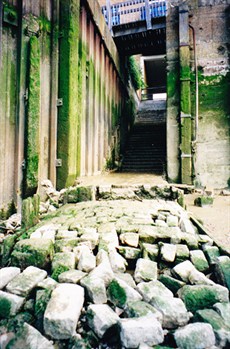Stairways to a gruesome past
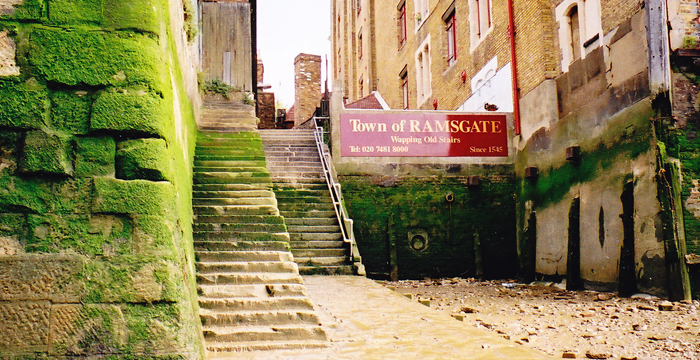
There are hundreds of stairs and ladders which give us access to the Thames in London. Over the centuries, people have walked down them to work, to catch a ship leaving the country, or to cross the river. On a few occasions though, they have been used for dishonest and murderous purposes. Wapping Old Stairs (above) have seen their fair share of both. These stairs were referred to as being ''Old' three hundred years ago and they have long been used as both public stairs and by watermen. The stairs were used for landing small boats and transferring people or cargo to the larger ships. There was usually a pub nearby which looked after the sailors, fisherman and dock workers who worked around the steps. And you'll see in the photo that the Town of Ramsgate pub, which originally hosted the fishermen and their catch from Ramsgate, is situated beside these steps.
The pub was originally named the Red Cow and was built in the early 1600s. It was here that Judge Jeffreys - the infamous 'Hanging Judge' who sentenced 200 people to death in one sitting - had his last drink before being grabbed by a mob on Wapping Old Stairs in 1688. He had done the bidding of the short-lived unpopular King James II, and now he was attempting a moonlight flit to Europe. He was a great lover of drink though and delayed getting on his boat while he had a last tipple in the pub and was captured on these stairs. He was taken to the Tower of London where he died, aged 40, not from execution, but from a painfully large kidney stone brought on by his excessive drinking.
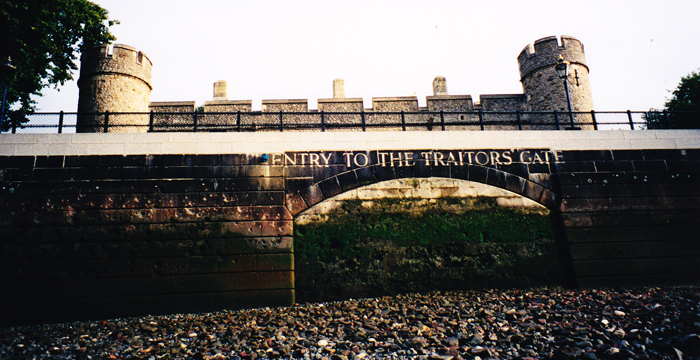
And here's a view I took from the shore of the Tower of London with the bricked-up entrance to Traitors' Gate. The gate was originally built in the 1270s, to provide access from the water to the castle for the kings in residence. The function of the Tower of London was originally to provide a royal power base in the City of London and a retreat for the royals in times of civil disorder. This changed over the years and was increasingly used as a prison for enemies of the state accused of treason who entered via Traitors' Gate. The Tower was last used as a royal residence by Anne Boleyn in 1533 when she was preparing for her coronation. Three years later she would return to the Tower as a prisoner passing through these same gates never to return. A few days later she was to meet her death from a sword stroke to her neck. From then on the Tower was known more for holding and striking the fear of death into prisoners than a royal residence.
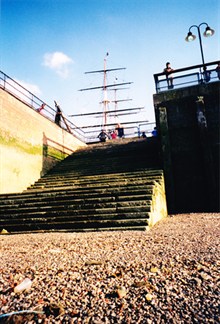 Anne
Boleyn had been taken prisoner at Greenwich before being brought to
the Tower and this set of steps pictured alongside is known as
Greenwich's Garden Stairs. I didn't find much of interest on the
day I took this, but did notice a couple of people who had enjoyed
a successful morning. They spent about two hours picking up dozens
of discarded bricks which had been offloaded onto the shore. They
were building a low wall in their garden, and had spotted the
bricks and were carrying them three or four at a time back to their
car. It was good to see some recycling of the Thames river
rubbish.
Anne
Boleyn had been taken prisoner at Greenwich before being brought to
the Tower and this set of steps pictured alongside is known as
Greenwich's Garden Stairs. I didn't find much of interest on the
day I took this, but did notice a couple of people who had enjoyed
a successful morning. They spent about two hours picking up dozens
of discarded bricks which had been offloaded onto the shore. They
were building a low wall in their garden, and had spotted the
bricks and were carrying them three or four at a time back to their
car. It was good to see some recycling of the Thames river
rubbish.
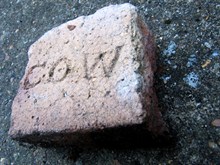 I retrieved my own piece of brick near here
though I have no idea why someone chiselled the word 'COW...' into
it and what the other half of the brick spelt if anything......
I retrieved my own piece of brick near here
though I have no idea why someone chiselled the word 'COW...' into
it and what the other half of the brick spelt if anything......
At the top of the Garden Stairs you can see the Cutty Sark, one of the speediest tea clippers of the 19th century and one of the last - as sail gave way to steam. The ship made many return trips with her cargo to the London ports, and was towed to Greenwich to her final resting place in 1954. Since this picture was taken, the ship has caught fire, benefitted from £45 million-worth of restoration work and was then reopened as a mighty smart museum ship. In addition, the world's largest collection of merchant navy figureheads were installed in the dry berth under the bow of the clipper for her reopening.
Another significant collection of these totems placed at the bow to guard the ship from sickness, rocks, storms, and dangerous winds, is also located in Greenwich. A few hundred yards from the Cutty Sark at the Queen's House, 30 ship figureheads have been mounted on the museum's walls. Queen's House is in the grounds of the National Maritime Museum , which had a previous incarnation as the Royal Naval College. The college in turn had been the splendid setting for the Royal Hospital for Seamen. The hospital, as the name implies, was built to look after seafarers and was part-subsidised from money (£6,000 plus) confiscated from the pirate Captain Kidd in 1700.
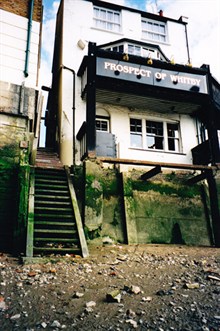 Captain Kidd, a Scottish captain
who had married well and lived in New York, was commissioned in
1696 by the Admiralty, to catch pirates. However, he started
raiding allied ships and was accused of embezzlement and killing a
crewman. When he learned that there was a warrant out for his
arrest, he buried his booty on an island, drew a map of its
whereabouts and sailed back to New York. He was sent to London for
trial and sentenced to hang at Execution
Dock, in view of the Prospect of Whitby (then known as The
Devil's Tavern) in Wapping.
Captain Kidd, a Scottish captain
who had married well and lived in New York, was commissioned in
1696 by the Admiralty, to catch pirates. However, he started
raiding allied ships and was accused of embezzlement and killing a
crewman. When he learned that there was a warrant out for his
arrest, he buried his booty on an island, drew a map of its
whereabouts and sailed back to New York. He was sent to London for
trial and sentenced to hang at Execution
Dock, in view of the Prospect of Whitby (then known as The
Devil's Tavern) in Wapping.
Execution Dock was used for more than 400 years to execute pirates, smugglers and mutineers all sentenced to death by Admiralty courts. The "dock", which consisted of a scaffold for hanging, was located on the low tide shoreline at Wapping (behind the town's underground station). With particular cruelty reserved for those convicted of acts of piracy, hanging was done with a shortened rope. This meant a slower death from strangulation on the scaffold, as the drop was insufficient to break the prisoner's neck.
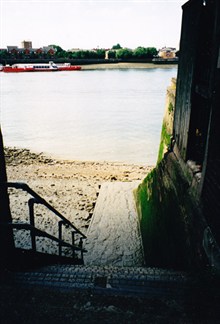 Captain Kidd was given huge amounts
of alcohol to dull the pain that was coming, taken to shore, and
given a chance to repent his piracy. He did not. He did however,
see an ex-lover who was laughing at his plight and he shouted "I have
lain with that bitch three times - and now she's come to see me
hanged!" Not the most inspired of last words, but heartfelt
nevertheless. The platform he was standing on was then taken away,
but the rope around his neck snapped. After another half an hour
spent replacing the noose Kidd was hung successfully, if slowly,
and his body was kept on the dock for another 36 hours, submerged
by three more tides. His bloated body was then covered in tar, held
in a metal cage (gibbeted) and hung up at Tilbury Docks for three
months, so that all sailors coming in and out of London would be
warned of the consequences of piracy. Check out this website by a man who
feels he knows where Kidd's treasure is buried and has conducted
research on the captain's story.
Captain Kidd was given huge amounts
of alcohol to dull the pain that was coming, taken to shore, and
given a chance to repent his piracy. He did not. He did however,
see an ex-lover who was laughing at his plight and he shouted "I have
lain with that bitch three times - and now she's come to see me
hanged!" Not the most inspired of last words, but heartfelt
nevertheless. The platform he was standing on was then taken away,
but the rope around his neck snapped. After another half an hour
spent replacing the noose Kidd was hung successfully, if slowly,
and his body was kept on the dock for another 36 hours, submerged
by three more tides. His bloated body was then covered in tar, held
in a metal cage (gibbeted) and hung up at Tilbury Docks for three
months, so that all sailors coming in and out of London would be
warned of the consequences of piracy. Check out this website by a man who
feels he knows where Kidd's treasure is buried and has conducted
research on the captain's story.
Two sailors convicted of murdering a ship's captain, were the final hangings at the dock on 16 December 1830. From then on, lesser offences than murder were often replaced with deportation. This now takes us back to where we started because prisoners due to join the boats taking them to Australia would be held in the Town of Ramsgate's cellars right next to Wapping Old Stairs.
Some other stairs....
